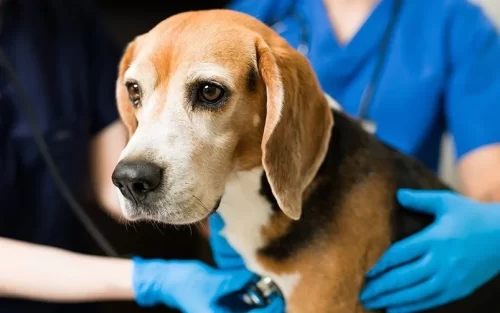Introduction
As a responsible dog owner, you want to keep your furry friend safe and healthy. So you may find yourself asking, ” How do I prevent my dog from getting heatstroke?” One of the most significant risks that dogs face, especially during the hot summer months, is heatstroke. This potentially life-threatening condition occurs when a dog’s body temperature rises too high. This can lead leading to dehydration, organ failure, and even death. In this article, we’ll explore the essential steps to prevent heatstroke in dogs and answer the following sub-questions:
- What are the signs and symptoms of heatstroke in dogs?
- How can I provide proper hydration for my dog?
- What are the best cooling methods for dogs?
- How can I keep my dog cool during walks and outdoor activities?
- How can I create a comfortable environment for my dog at home?
By following these guidelines, you’ll be well-prepared to keep your dog safe and comfortable in the heat, allowing them to enjoy the outdoors without the risk of heatstroke.
Signs and Symptoms of Heatstroke in Dogs
Recognizing the signs and symptoms of heatstroke in dogs is crucial for preventing a life-threatening situation. Early intervention can make all the difference, so be vigilant for these common indicators:
- Excessive panting or drooling: Panting is a normal way for dogs to cool down, but excessive panting can be a sign of overheating. Drooling can also indicate heat stress.
- Rapid or irregular heartbeat: An increased heart rate is a common symptom of heatstroke. Check your dog’s pulse by placing your fingers on the inside of their hind leg, near the point where it meets their body.
- Lethargy or weakness: Dogs experiencing heatstroke may appear weak, sluggish, or have trouble standing or walking.
- Vomiting or diarrhea: Gastrointestinal distress, such as vomiting or diarrhea, can be a sign of severe heat stress.
- Red or pale gums: Discolored gums may indicate poor blood circulation, a symptom of heatstroke. Press your finger gently on your dog’s gums to see how quickly the color returns after you release the pressure.
- Elevated body temperature (above 103°F): Use a rectal thermometer to check your dog’s temperature. Normal body temperature for dogs is between 101°F and 102.5°F. Anything above 103°F is considered abnormal and may indicate heatstroke.
If you suspect your dog is experiencing heatstroke, it’s essential to act immediately. Move them to a cooler area, apply cool (not cold) water to their fur, and contact your veterinarian for further guidance.
How Do I Prevent My Dog From Getting Heatstroke With Hydration?
Hydration plays a vital role in preventing heatstroke in dogs. Ensuring your dog has access to clean, fresh water at all times is crucial, especially during hot weather. Dogs tend to drink more water when it’s hot, so monitoring their water intake is important. Here are some tips for providing proper hydration to your dog:
- Keep multiple water dishes around your home and yard: Providing several water sources can encourage your dog to drink more and stay hydrated. This is particularly helpful if your dog spends time in different areas throughout the day.
- Clean water dishes regularly: Dirty water dishes can harbor bacteria, which may deter your dog from drinking. Cleaning the dishes regularly ensures your dog always has access to fresh water.
- Encourage hydration through ice cubes or flavored ice treats: Adding ice cubes to your dog’s water or offering flavored ice treats can make drinking more enticing. Be sure to use dog-safe flavors and ingredients.
- Use collapsible or portable water dishes during outdoor activities: When you take your dog on walks or other outdoor adventures, bring along a collapsible or portable water dish to ensure they have access to water when needed.
- Monitor your dog’s urine color: A well-hydrated dog will have light yellow urine. Dark yellow or amber-colored urine may indicate dehydration and the need for increased water intake.
By following these hydration tips, you’ll help reduce the risk of heatstroke in your dog and promote their overall health and well-being.
Cooling Methods for Dogs
Various cooling methods can help maintain your dog’s body temperature and prevent heatstroke. Some of these methods include:
- Cooling mats or pads: These products can be filled with water or gel and provide a cool surface for your dog to lie on. They work by absorbing heat from your dog’s body and dissipating it into the surrounding environment.
- Cooling vests: These garments are designed to be soaked in water and placed on your dog, helping to dissipate heat through evaporation. Choose a vest that fits your dog snugly but comfortably, and make sure it covers the majority of their body for maximum cooling effect.
- Frozen treats: Offer your dog ice cubes, frozen fruit, or specialized dog ice treats to help them cool down from the inside out. Avoid using human foods that are toxic to dogs, such as grapes, raisins, or chocolate.
- Wading pools: A shallow pool of water can be a fun and effective way for your dog to cool off during hot days. Make sure the water is clean and shallow enough for your dog to stand comfortably.
- Fans and air conditioning: Ensure your home is well-ventilated and maintains a comfortable temperature for your dog. Keep fans and air conditioning units at a safe distance from your pet to prevent injury.
How Do I Prevent My Dog From Getting Heatstroke While Exercising?
Exercise is essential for your dog’s health, but during hot weather, it’s crucial to take extra precautions to prevent heatstroke. Consider the following tips:
- Walk your dog during cooler parts of the day, such as early morning or late evening. This helps avoid the hottest times when the sun’s rays are most intense.
- Avoid hot surfaces like asphalt or sand that can burn your dog’s paws. Place your hand on the surface for a few seconds; if it’s too hot for you, it’s too hot for your dog.
- Choose shaded areas for walks and playtime to reduce direct sun exposure. Look for parks with tree cover or walking trails with plenty of shade.
- Carry water and a portable dish to ensure your dog stays hydrated during outdoor activities. Offer water frequently, especially during longer walks or more intense play sessions.
- Keep exercise sessions short and watch for signs of overheating or exhaustion. Adjust your dog’s activity level based on their breed, age, and fitness level, as some dogs are more prone to heatstroke than others.
- Use a cooling vest or wet towel to help regulate your dog’s body temperature during outdoor activities. Remember to re-wet the vest or towel as needed to maintain its cooling effect.
Be mindful of humidity levels, as high humidity can make it difficult for dogs to cool themselves through panting. In these conditions, it’s even more important to keep exercise sessions short and provide ample opportunities for your dog to rest and cool down.
How Do I Prevent My Dog From Getting Heatstroke at Home?
Keeping your dog’s home environment cool and comfortable is key to preventing heatstroke. Take the following measures to ensure your furry friend stays safe during hot weather:
- Maintain a comfortable indoor temperature by using fans or air conditioning. Position fans to circulate air throughout the room, and keep the air conditioning at a moderate temperature to avoid overcooling your pet.
- Close curtains or blinds to block direct sunlight and reduce heat buildup in your home. Consider using reflective window film or thermal curtains for additional heat control.
- Provide access to cool, shaded areas in your yard for outdoor relaxation. Ensure your dog has a shaded spot to retreat to, such as under a tree, pergola, or awning.
- Offer multiple resting spots with varying temperatures so your dog can find their preferred comfort level. Consider providing raised dog beds or cooling mats to help regulate your pet’s body temperature.
- Regularly groom your dog to remove excess hair and promote better airflow around their skin. Regular grooming is especially important for dogs with thick or double coats, as it helps prevent matting and allows air to circulate more freely.
Conclusion
Heatstroke in dogs is a serious concern, but by being proactive and attentive, you can minimize the risks and keep your furry friend safe and healthy. Familiarize yourself with the signs and symptoms of heatstroke, provide proper hydration, utilize cooling methods, and create a comfortable home environment to prevent this potentially life-threatening condition.
Remember to consider your dog’s breed, age, and fitness level when planning outdoor activities, as some dogs are more susceptible to heatstroke than others. Always consult with your veterinarian for personalized advice on keeping your dog safe in hot weather. By following these guidelines, you can enjoy the warm months with your canine companion, knowing that you’re taking the necessary precautions to prevent heatstroke.



